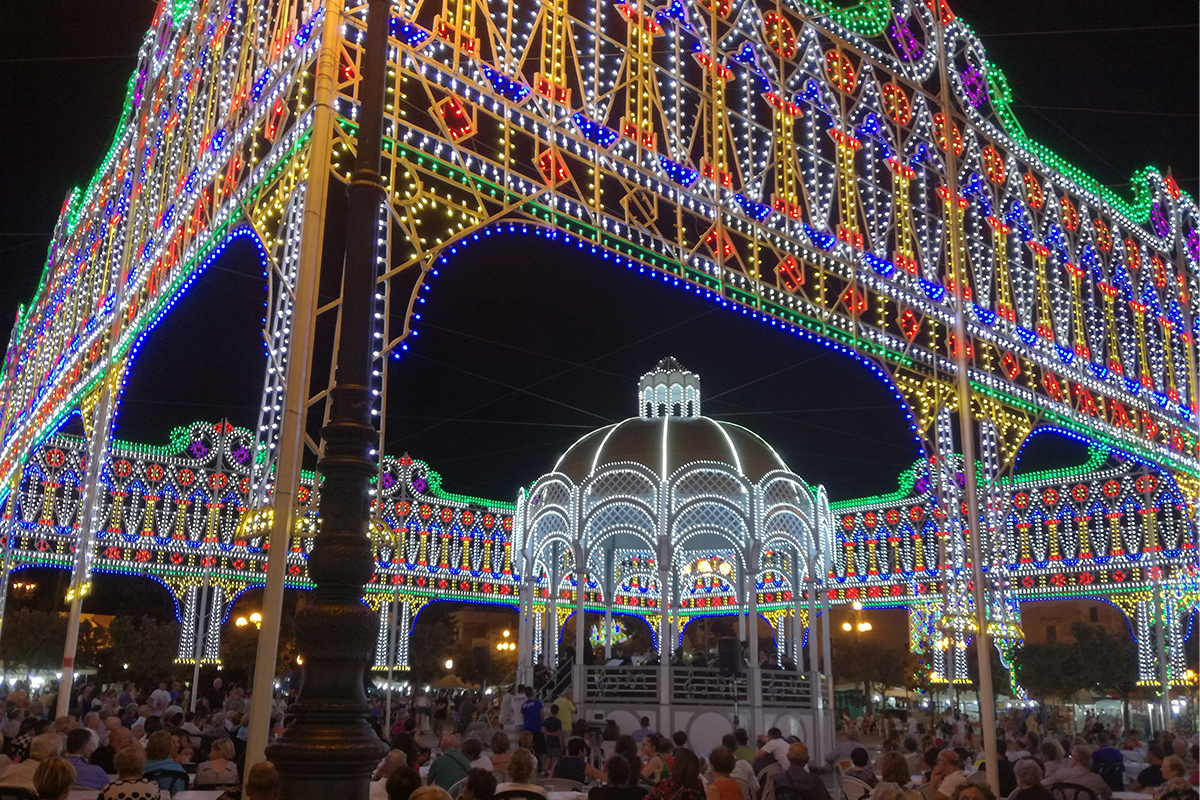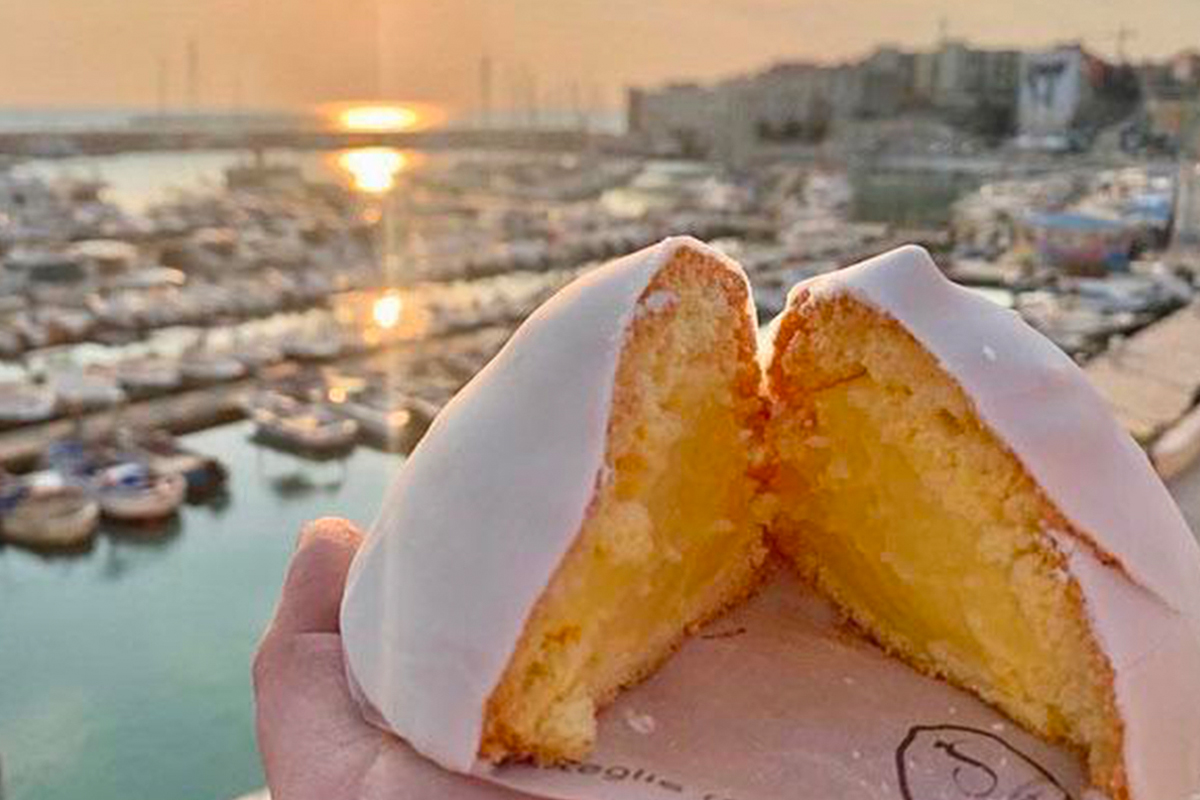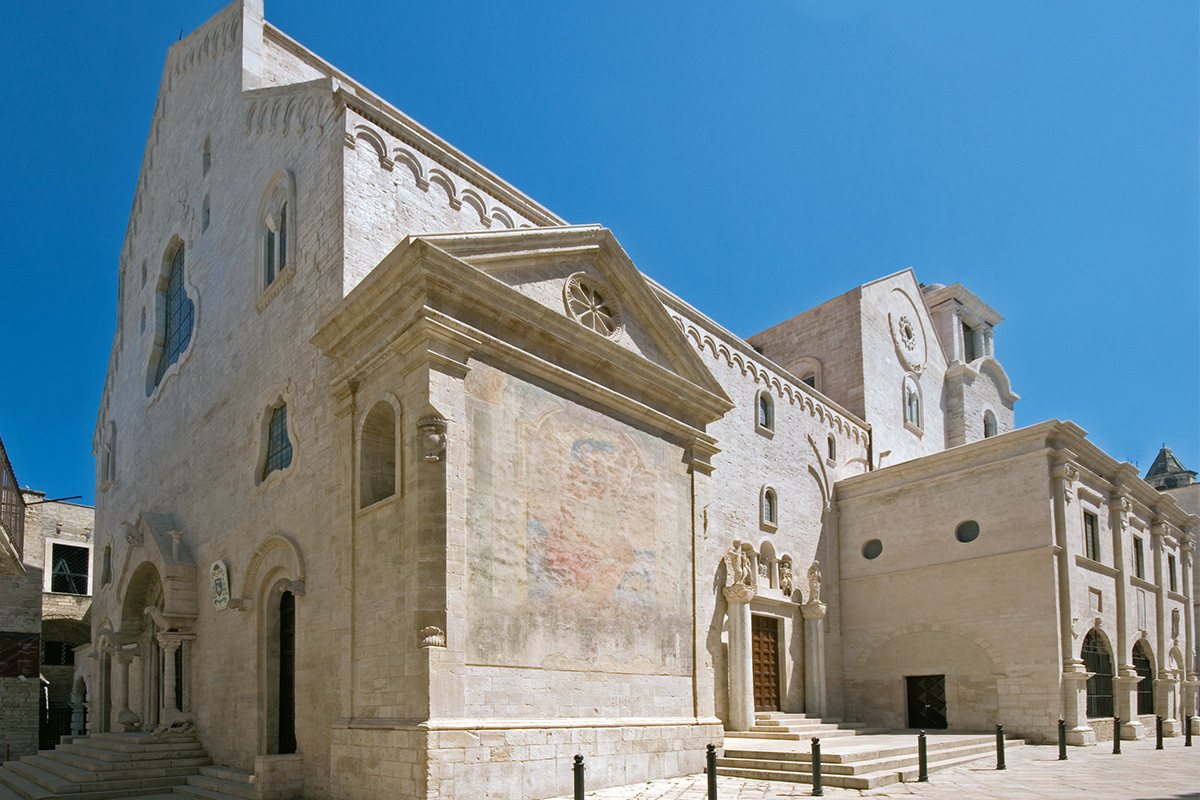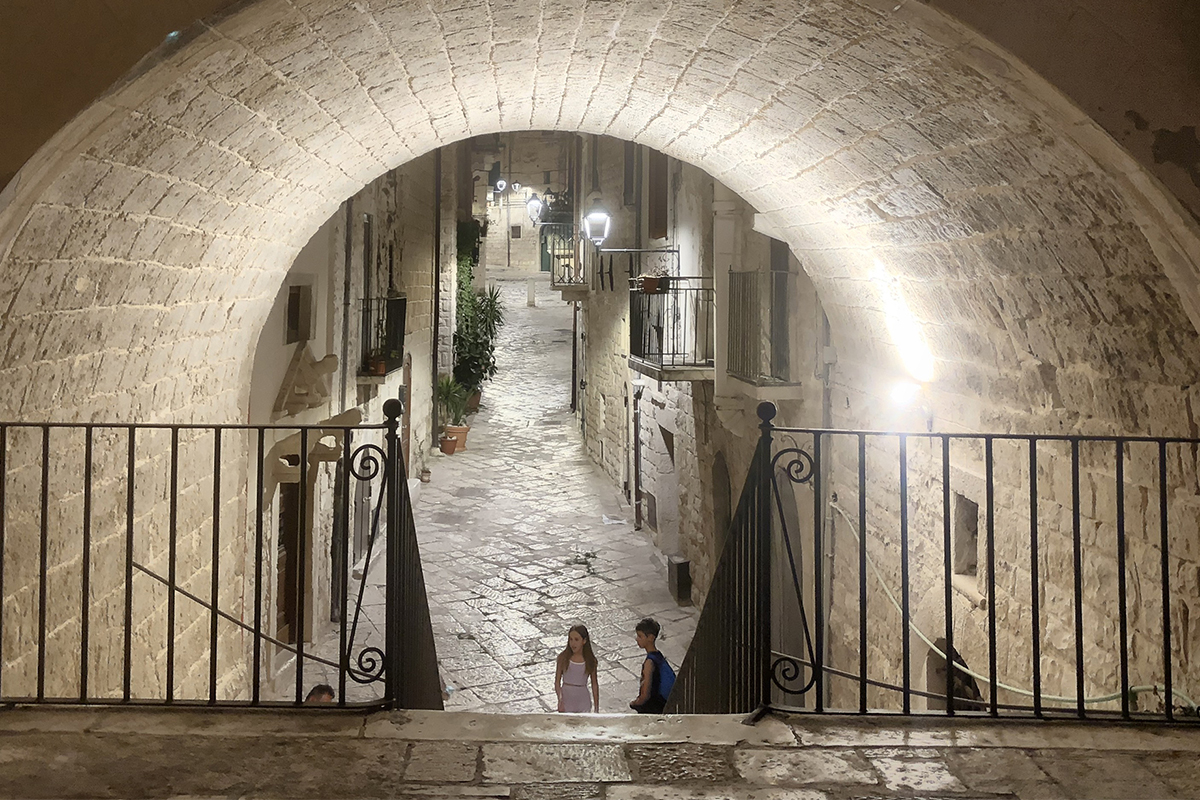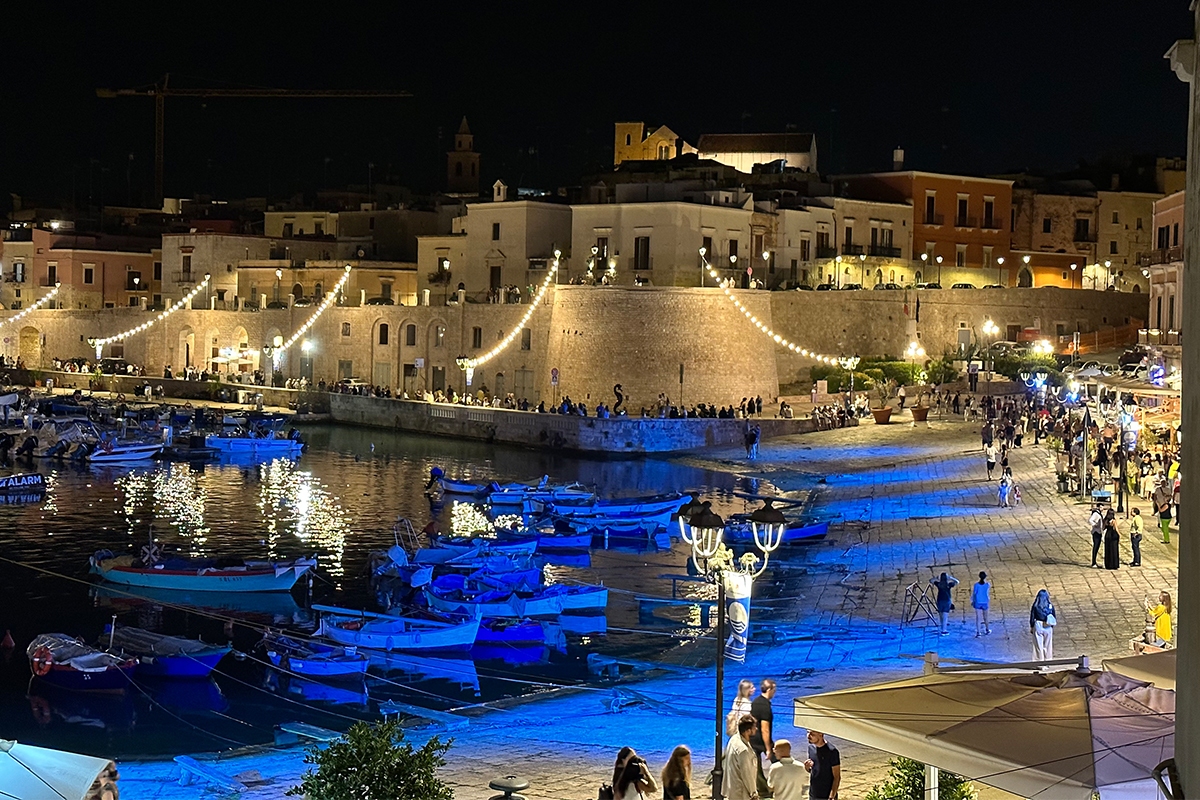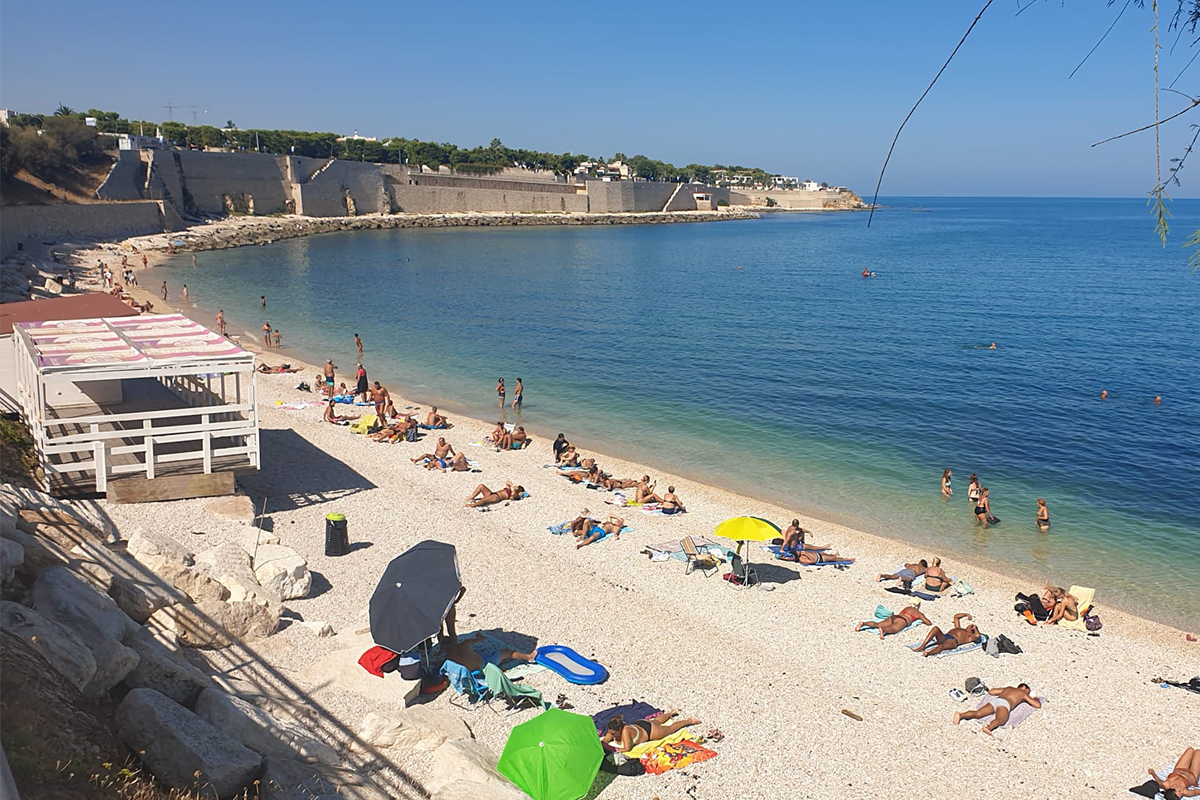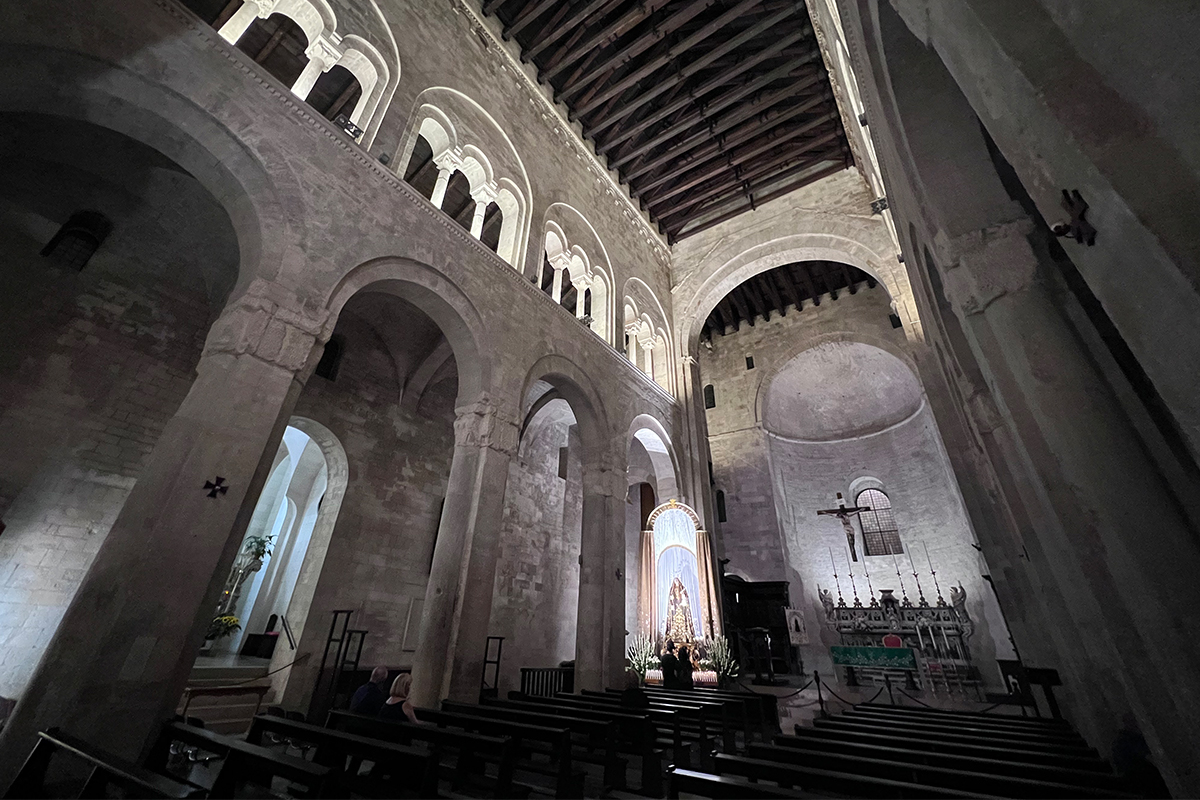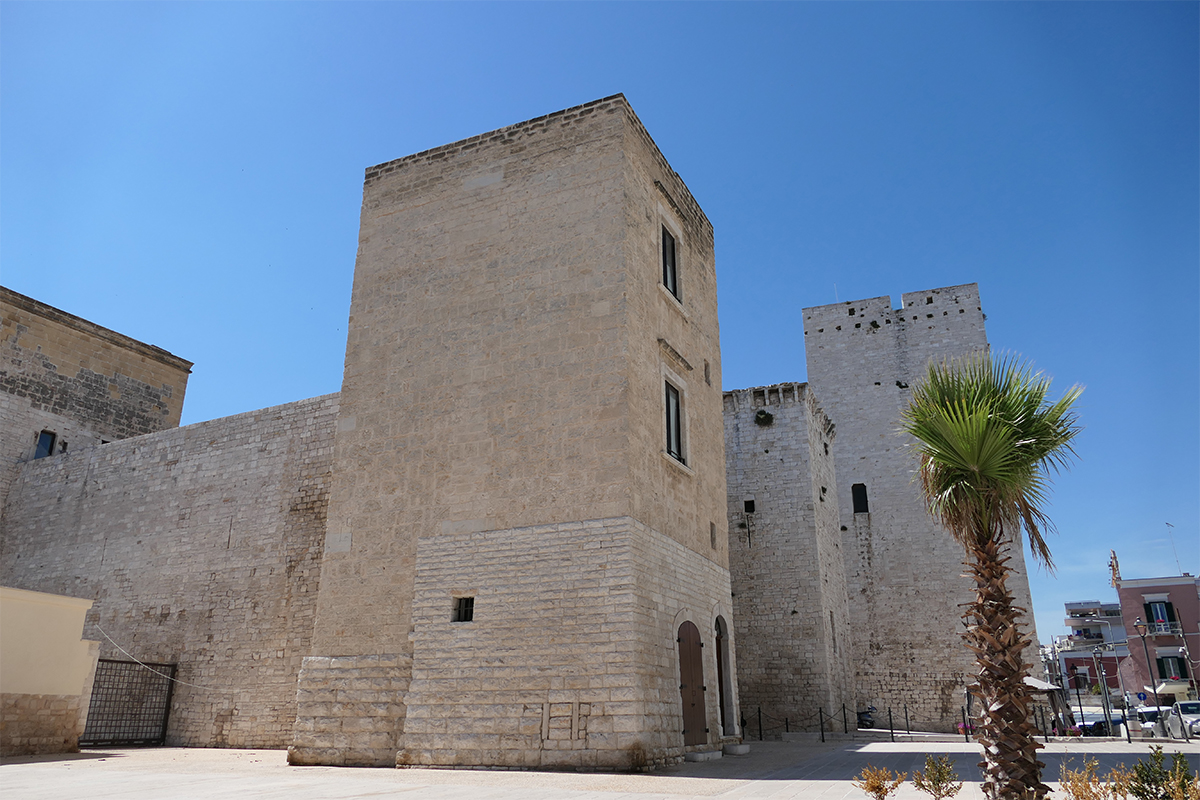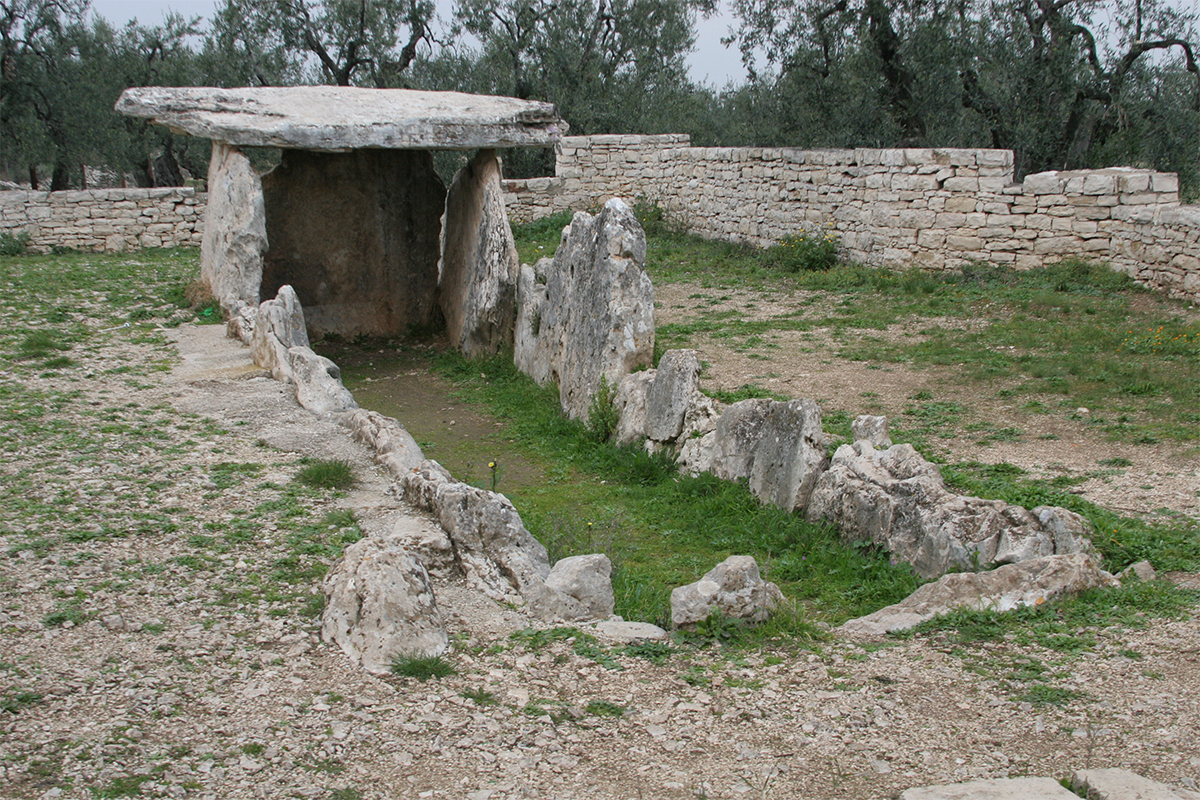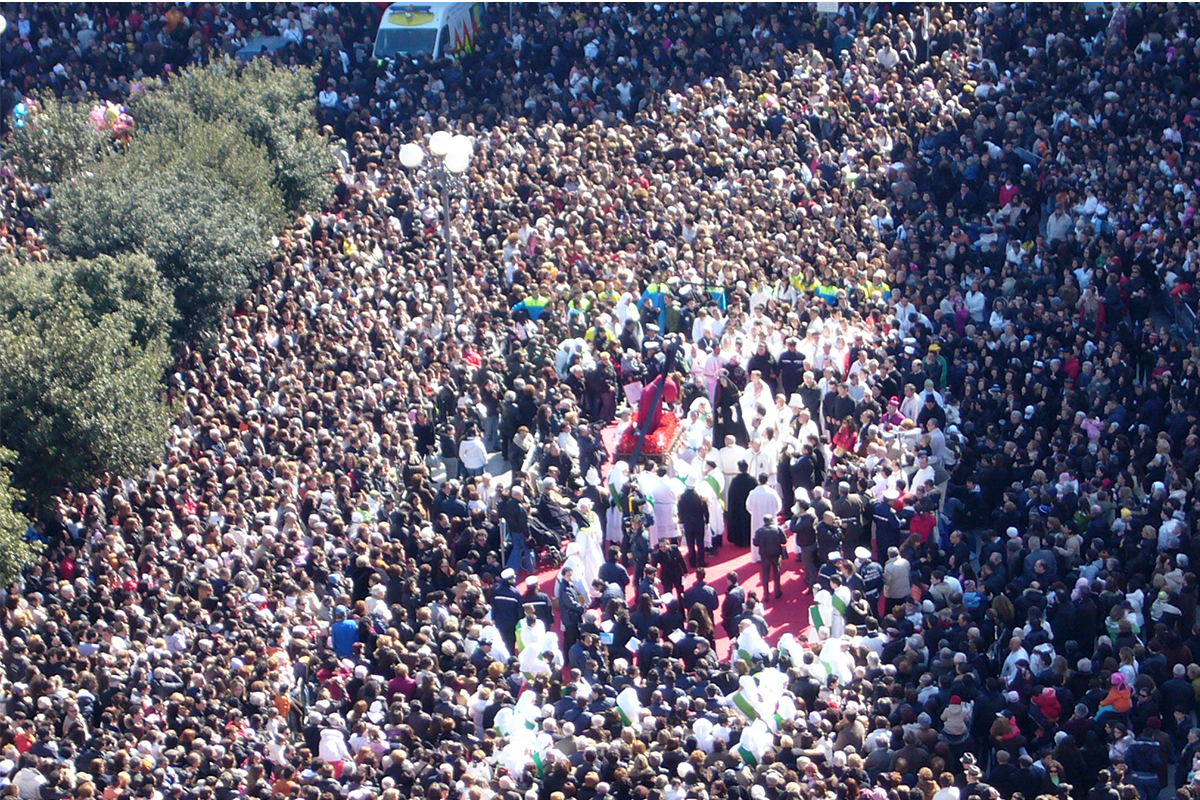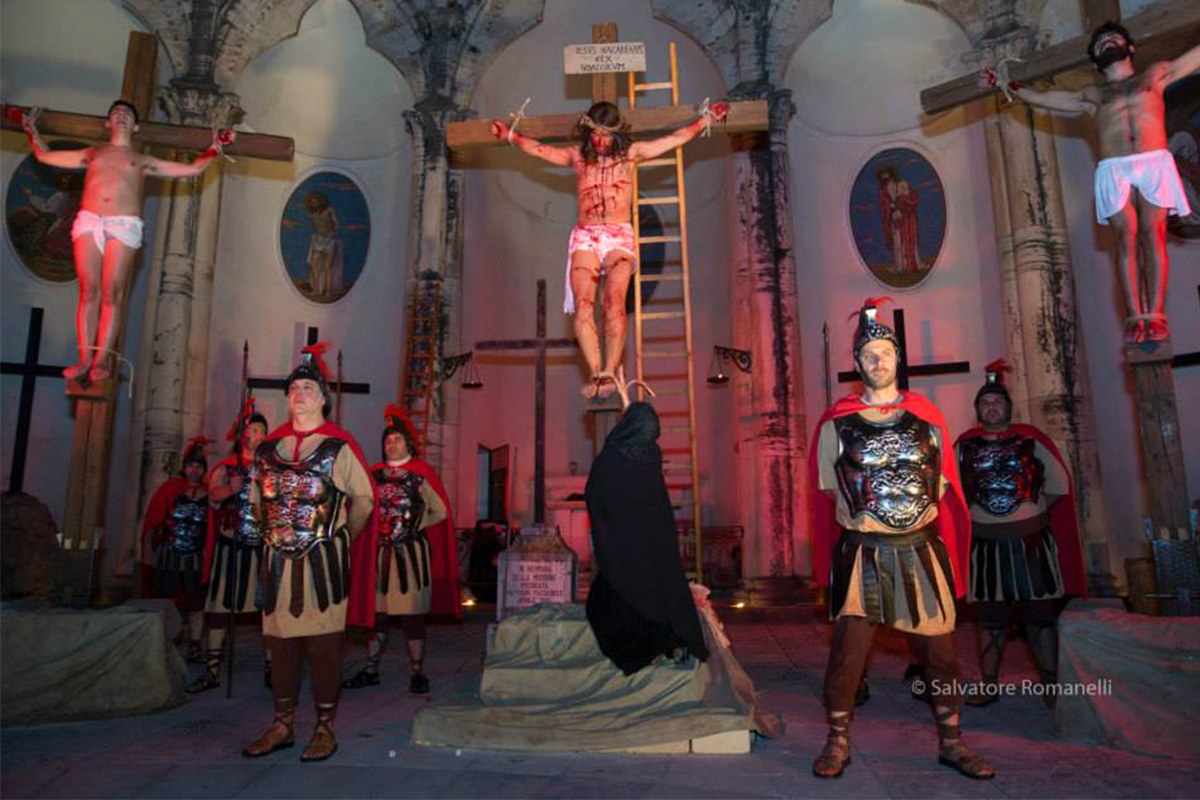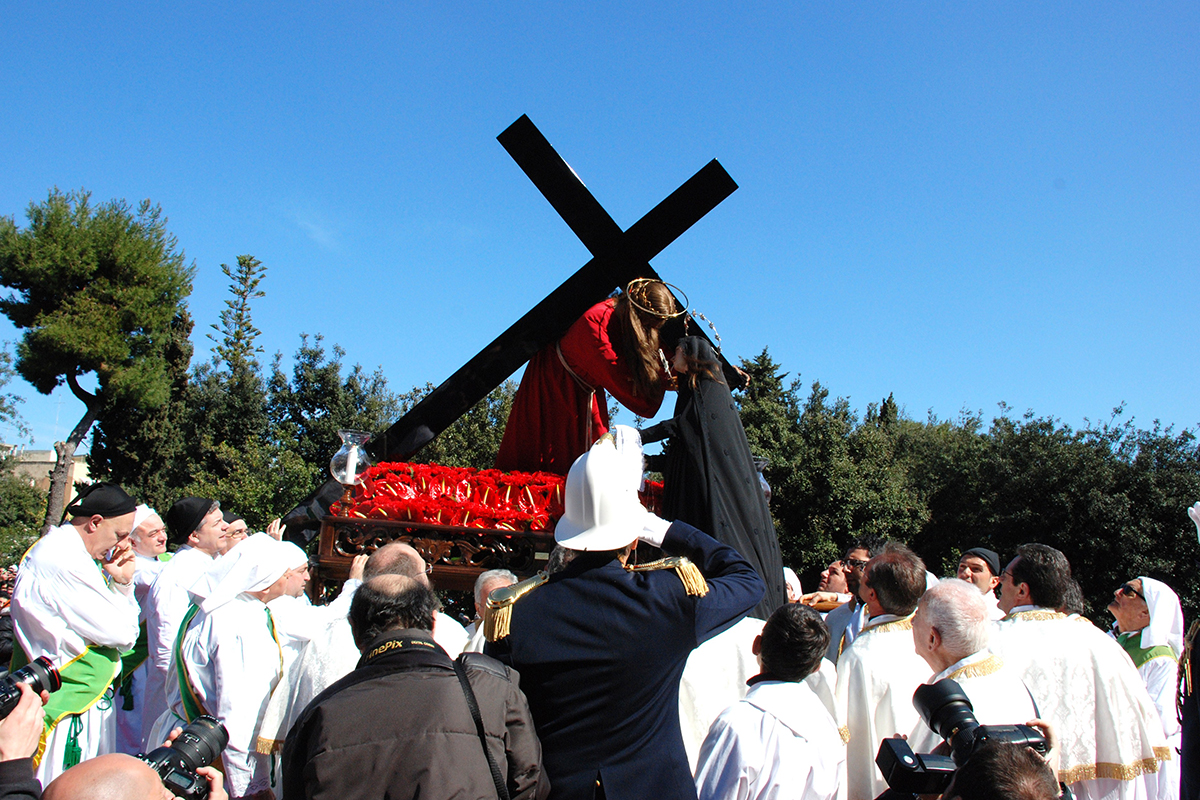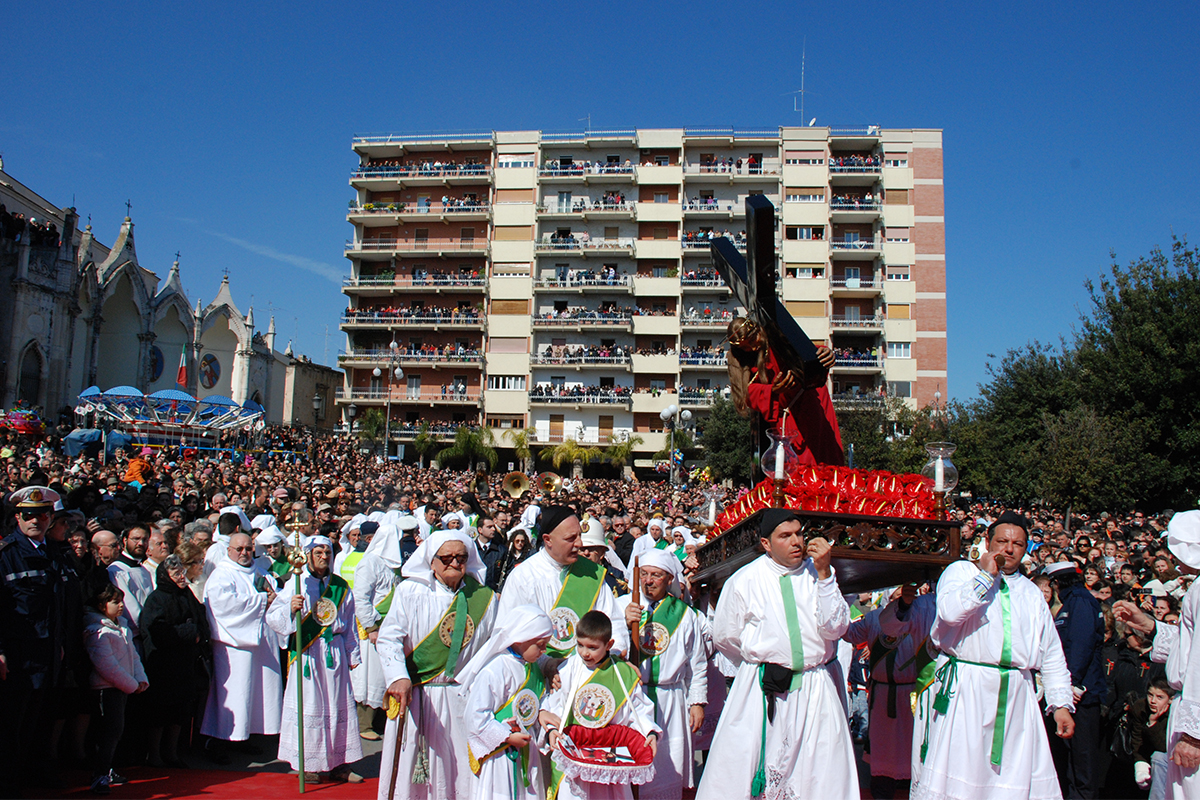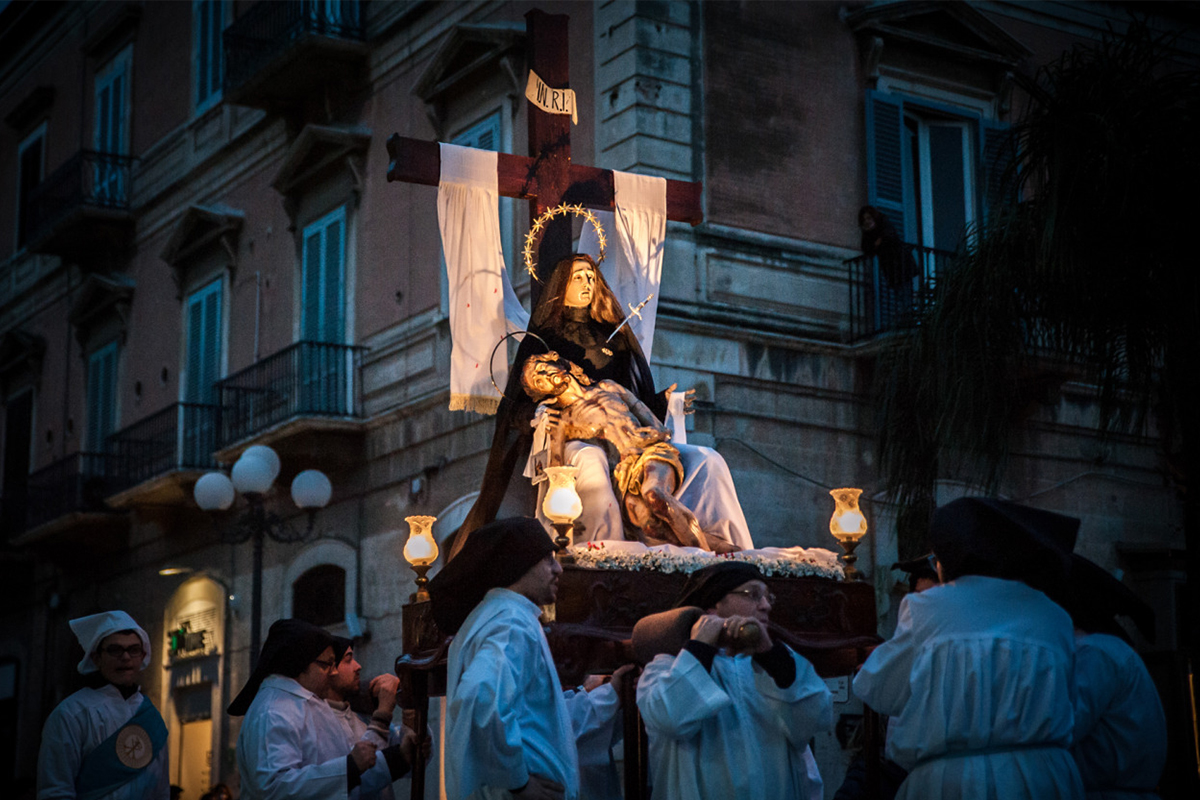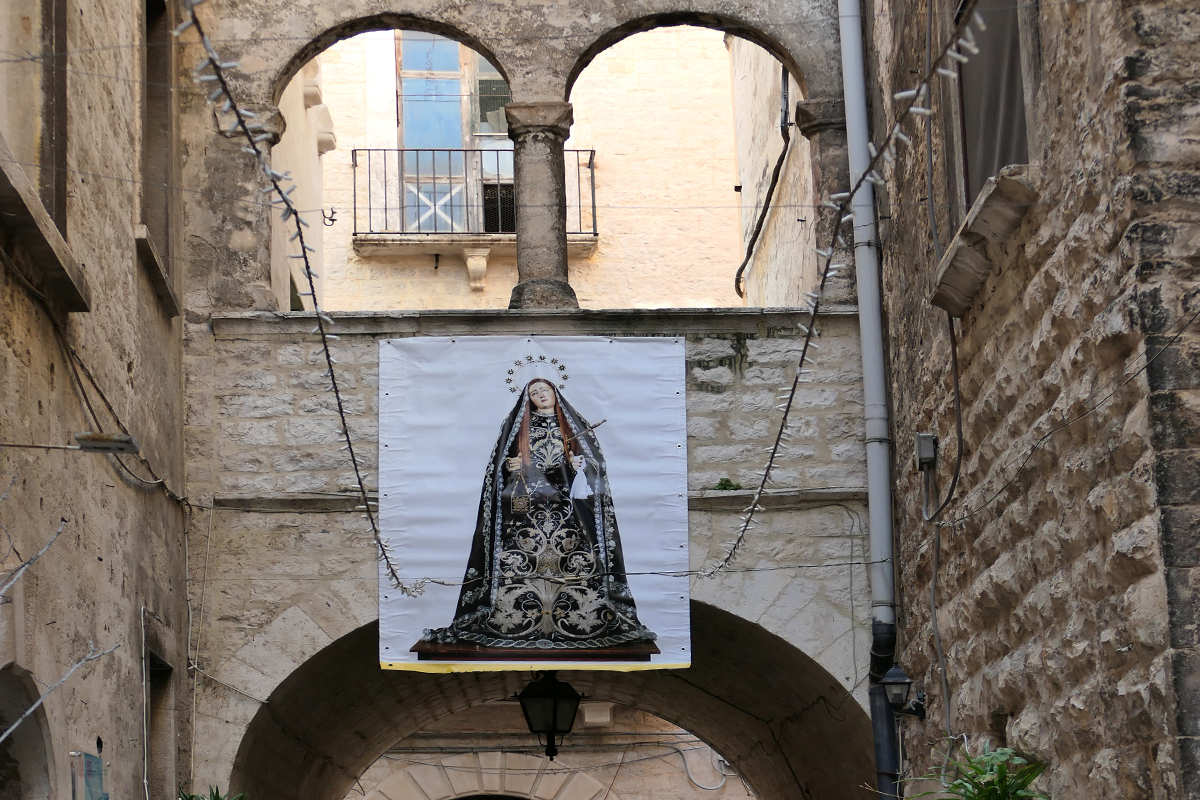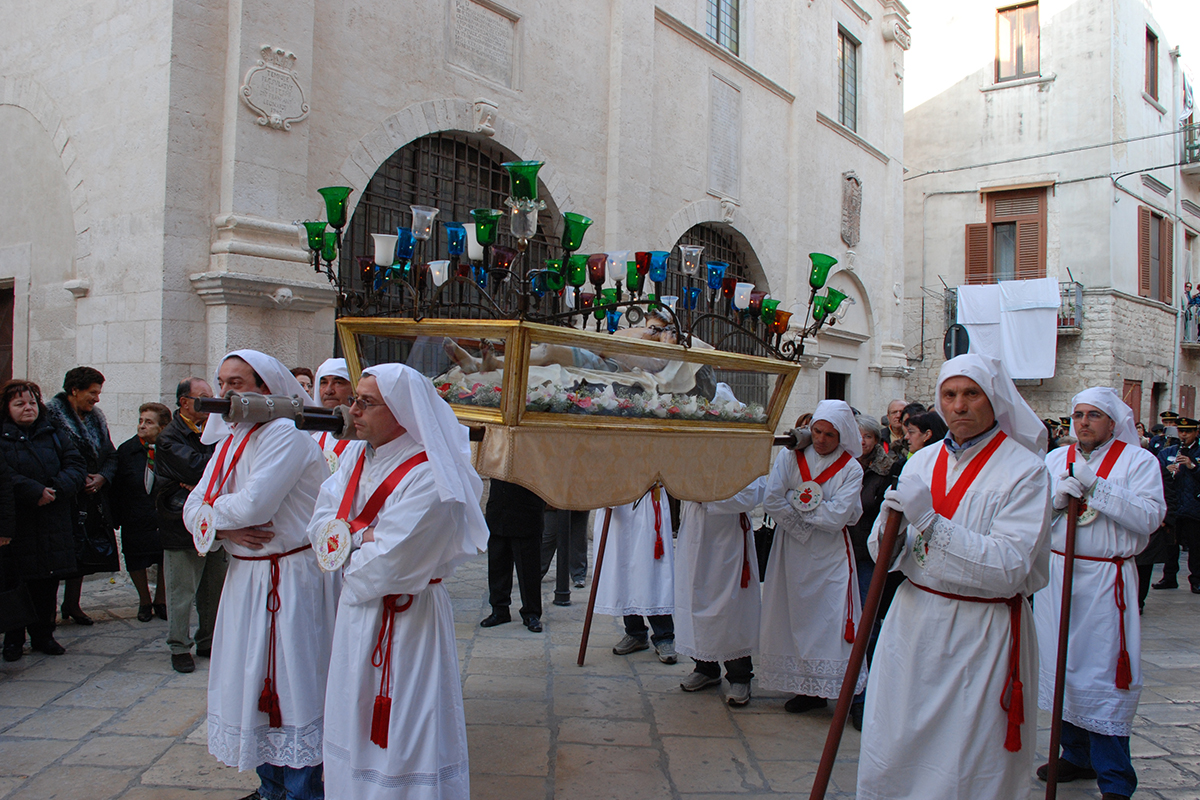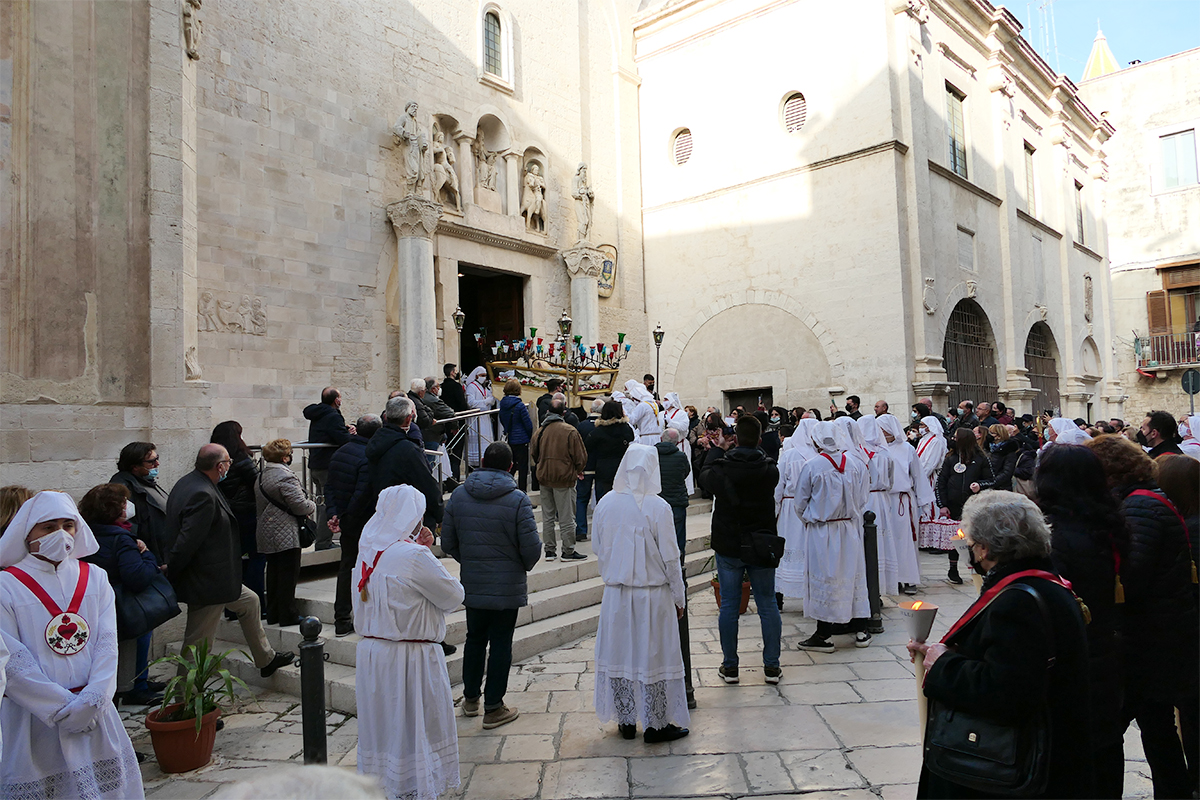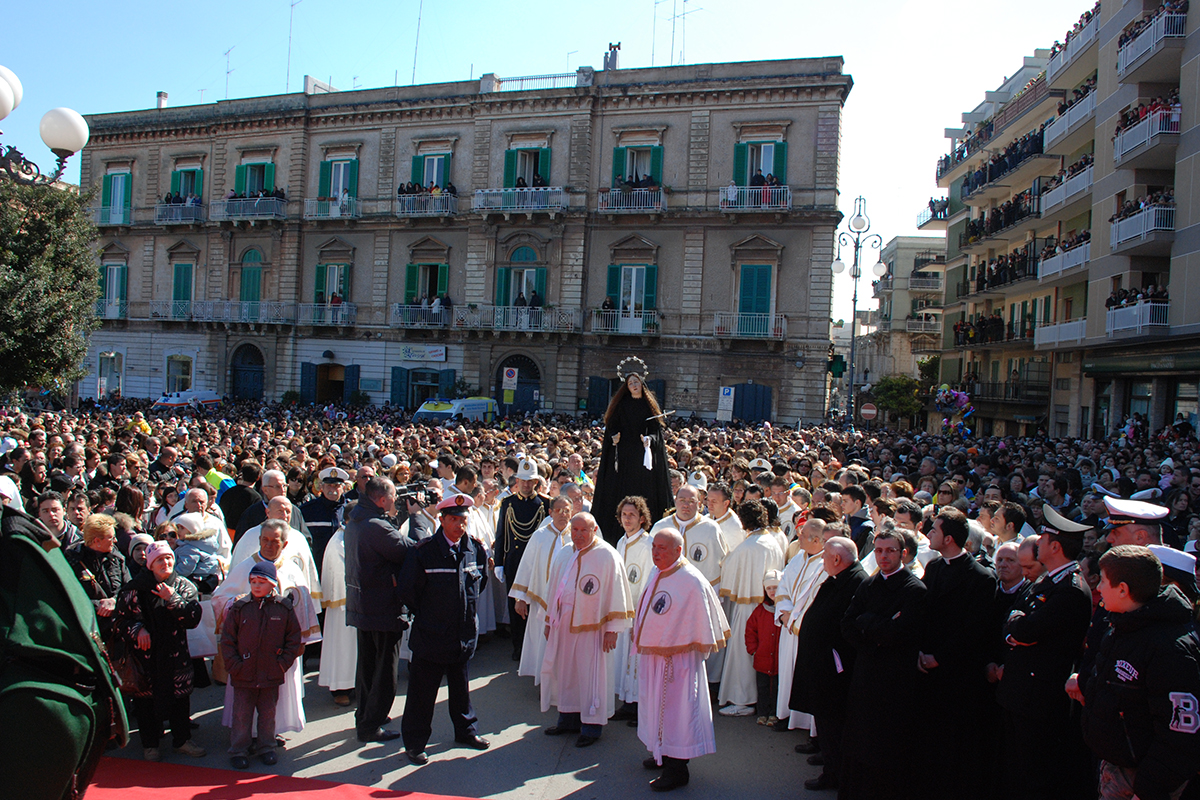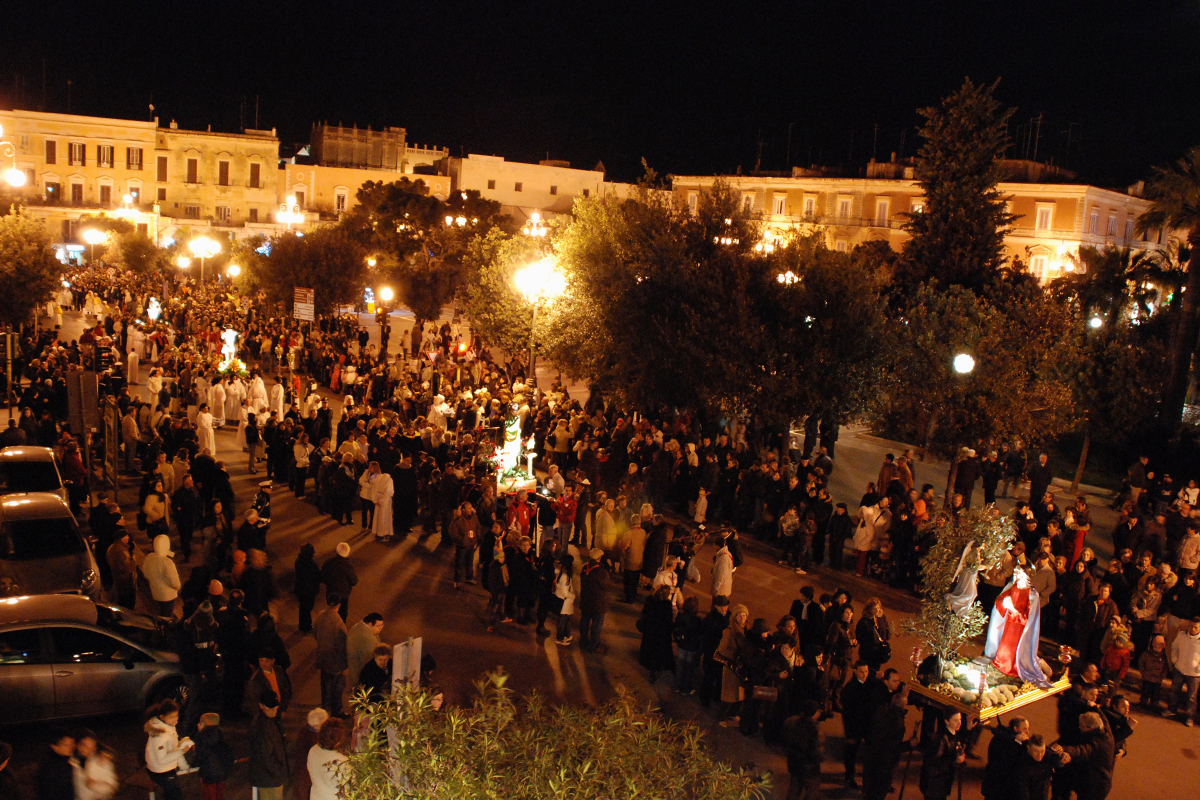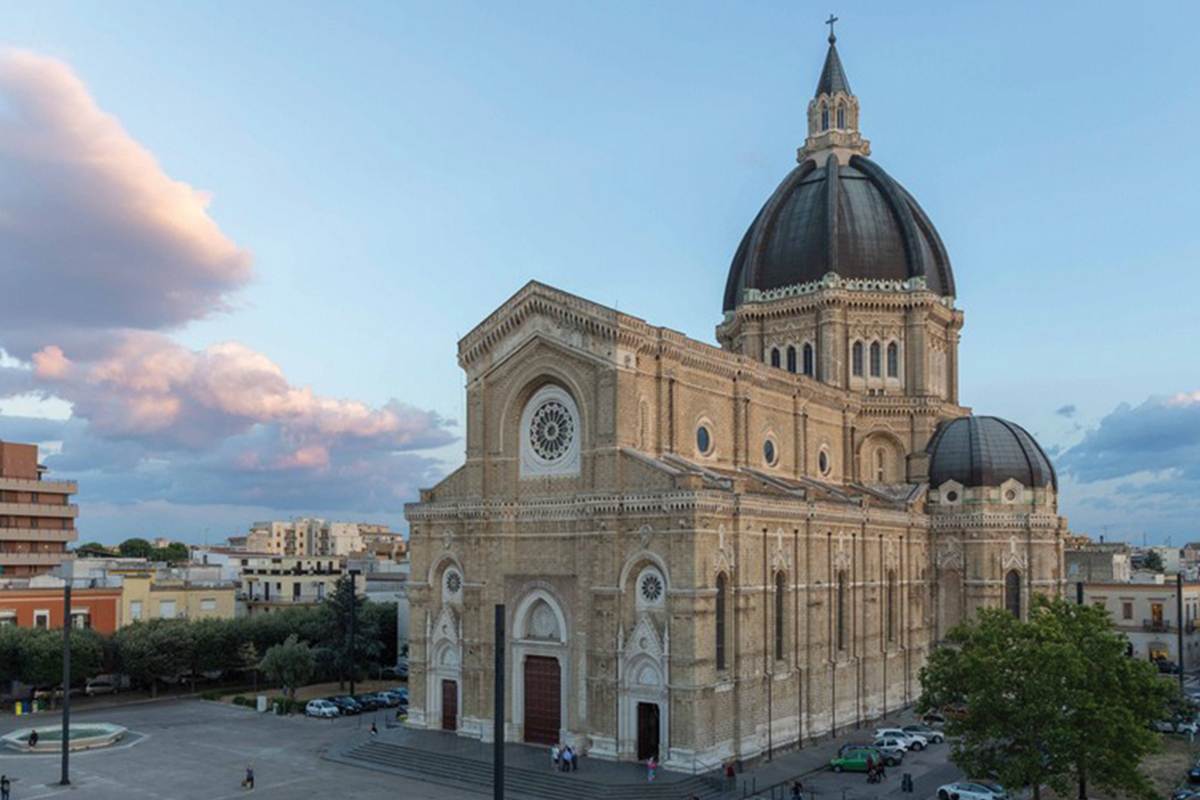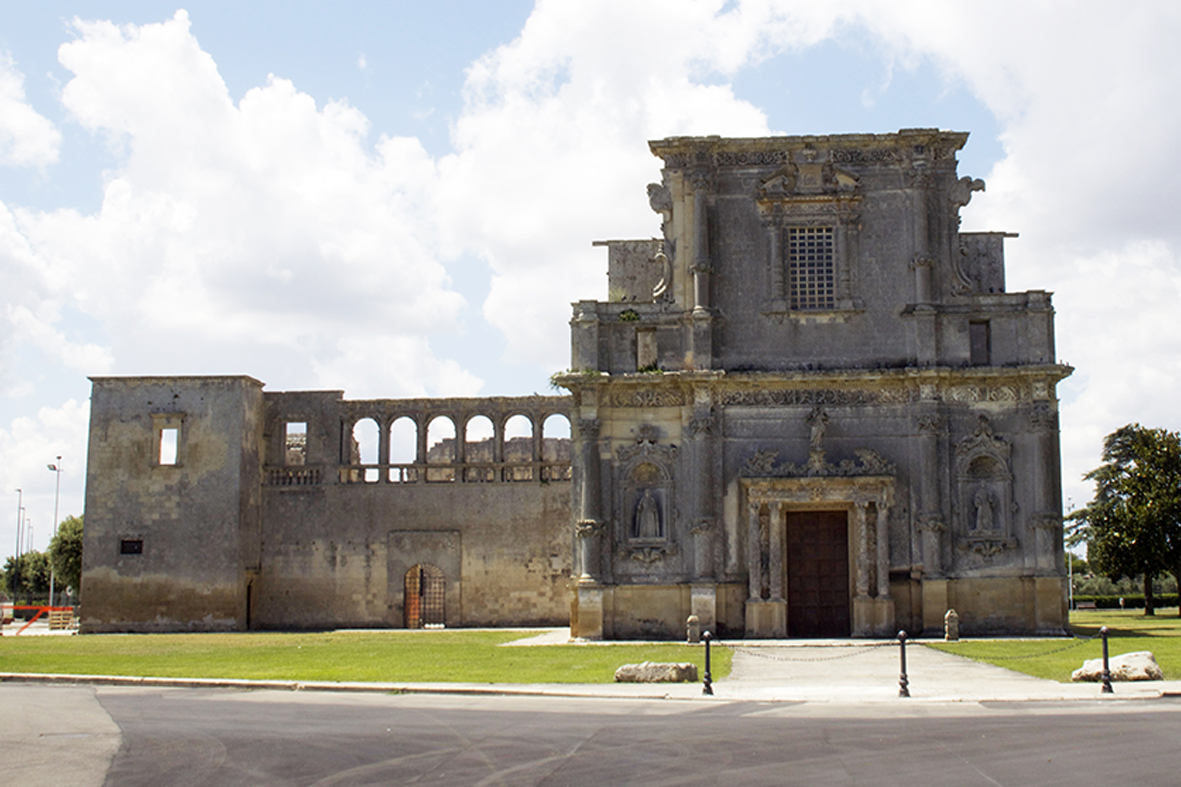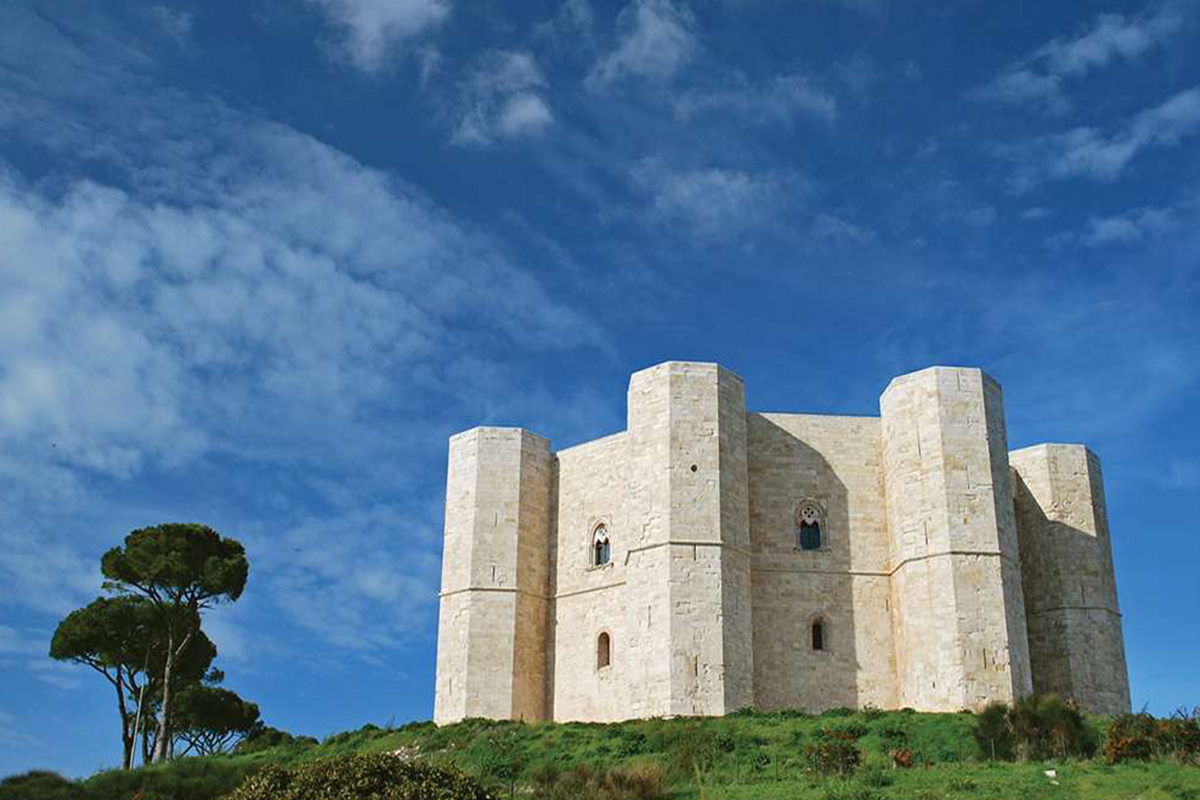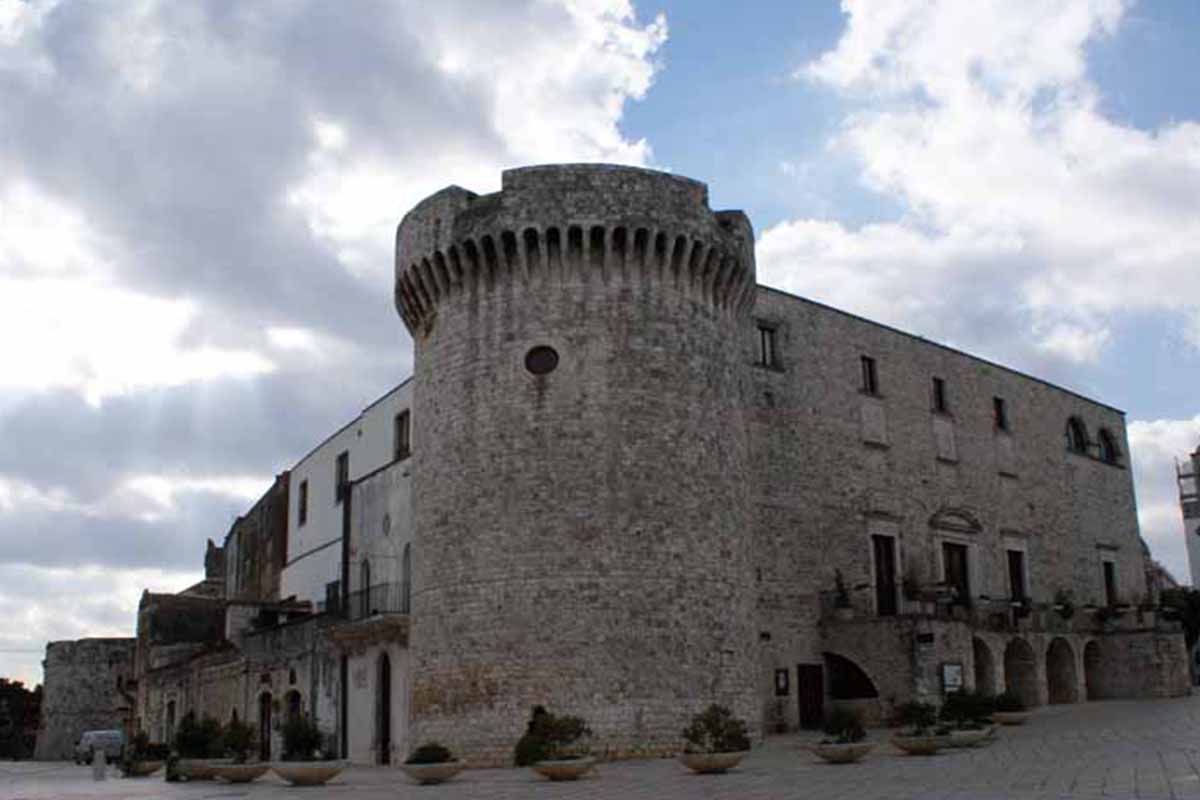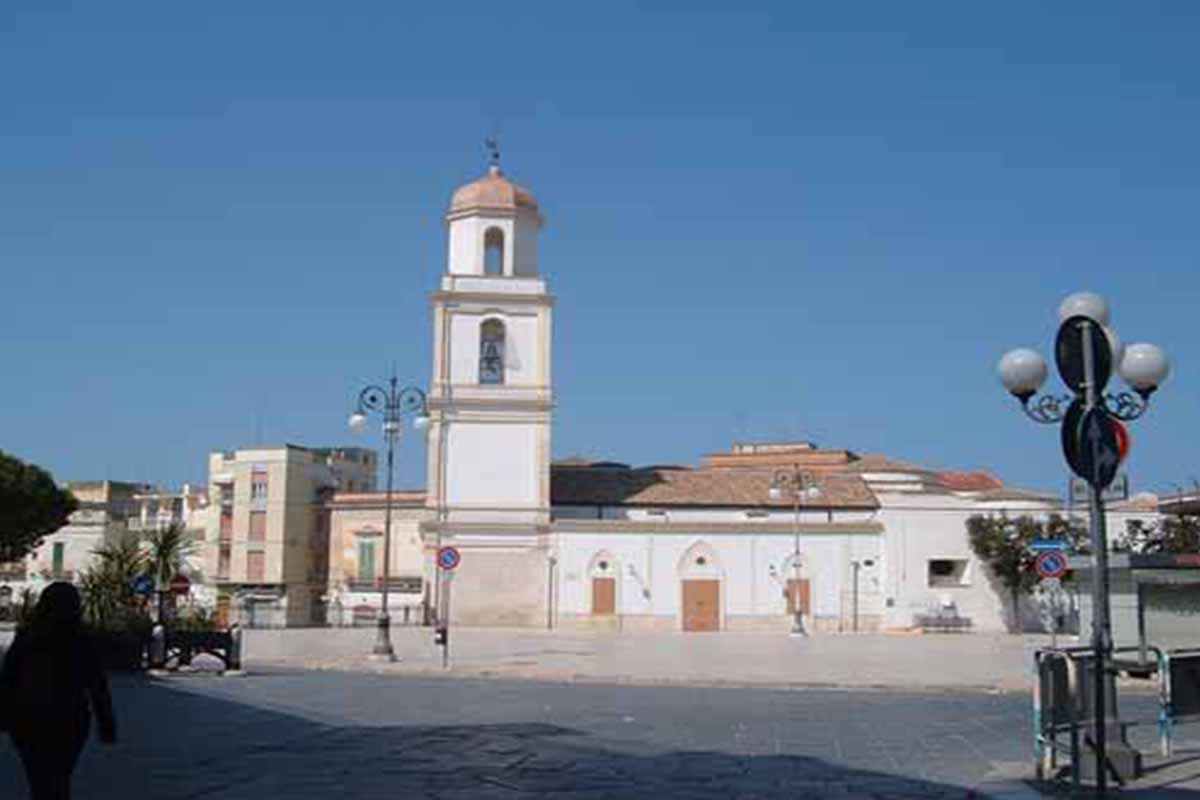Cities
The Encounter
10 Novembre 2024
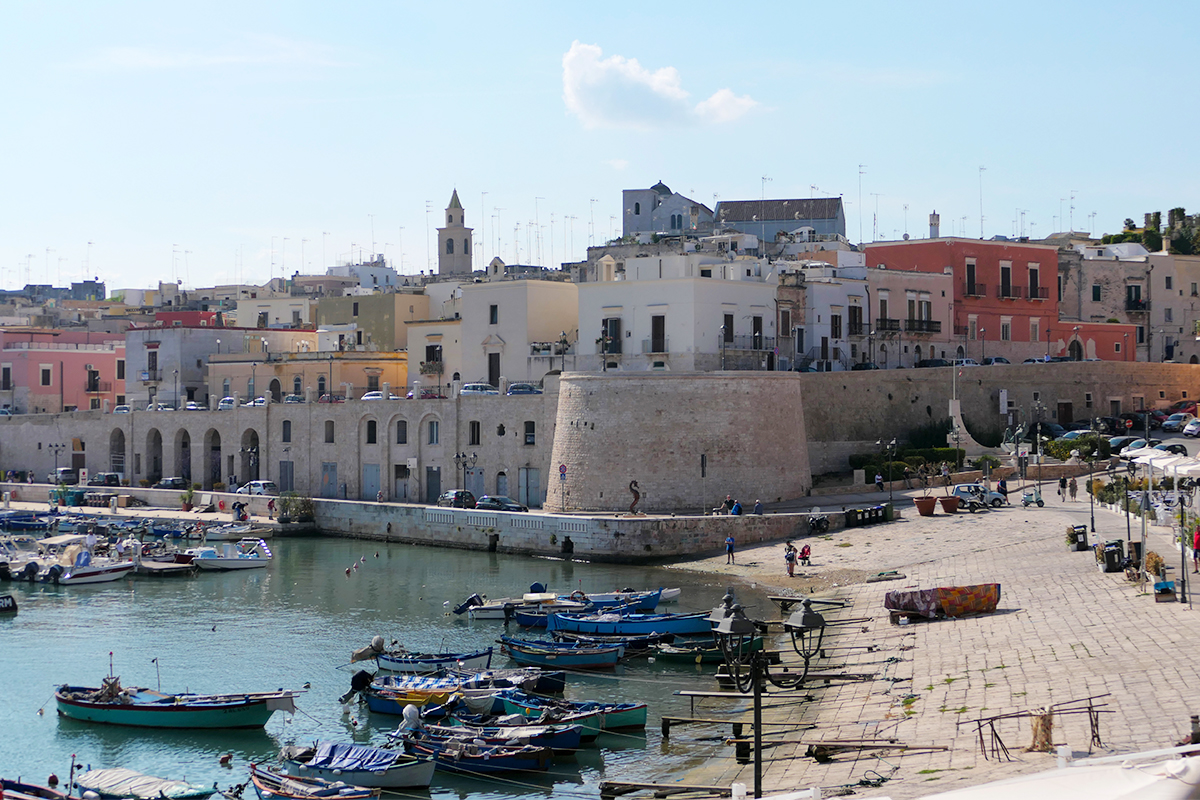
Located 32 km northwest of Bari, the territory of the city of BISCEGLIE (BAT) is characterized by the presence of many lame, the beds of ancient rivers, and about eight kilometers of coastline. Bisceglie, also known as the “City of Dolmens and Normans,” has a municipal emblem featuring a red shield with a golden oak tree at its center.
According to some theories, the name of the city derives from an ancient term used to designate this tree, Vescegghie. The golden color of the oak is due to Charles II of Anjou, who wished to reward the city for its loyalty. In 1532, Charles V allowed the municipality to imprint a crown on the civic coat of arms as a symbol of loyalty to the empire.
The city is located in a cove along the Adriatic coast and boasts a well-equipped tourist port, enchanting white-pebble beaches that attract tourists from all over, and is specialized in the production and trade of agricultural products, such as vegetables and cherries, as well as fishing and the trade of seafood products. These productions also give rise to typical dishes of great flavor.
The old town, situated in an elevated position, preserves numerous historical and architectural landmarks, such as 15th- and 16th-century houses and palaces, including the famous Tupputi Palace, known for hosting Carbonari Risorgimento meetings in 1820, the splendid Cathedral (1073) dedicated to Saint Peter, which contains the remains of the three Patron Martyr Saints, Mauro, Sergio, and Pantaleone, the ancient Church of Sant’Adoeno (1074), the Church of Santa Margherita (1197), and the remains of the Castle complex built by the Normans and Swabians, later expanded and fortified by the Angevins.
The city of Bisceglie is featured in all archaeological itineraries for the presence, in its countryside, of several funerary constructions dating back to the Middle Bronze Age, the Dolmens: the most important and best-preserved one is called “La Chianca.”
The Patronal Festival, held in the first days of August, is deeply evocative and rooted in the ancient event of the “Translation of the Saints,” which took place in 1167 when the remains of Saints Mauro, Sergio, and Pantaleone were exhumed from the hamlet of Sagina.
In addition to typical Apulian specialties, such as strascinati with turnip tops or its variation of the calzone, a focaccia stuffed with spring onions, Bisceglie offers unique delights. Among them are the colve, an autumn fruit salad prepared on November 2, with boiled wheat, chopped almonds, walnuts, chocolate pieces, pomegranate seeds, and a drizzle of cooked must (vin cotto), and the renowned "Sospiri," sponge cake desserts filled with custard and covered with a delicate glaze.
Legend has it that the Poor Clares prepared these sweets for the wedding between Lucrezia Borgia and Alfonso d’Aragona, Duke of Bisceglie, but the bride never arrived, and the guests, sighing, indulged in these delicacies.
To visit: Historic Center, Co-Cathedral, Church of Santa Margherita, Tupputi Palace, “La Chianca” Dolmen, Saint Croce Caves, Castle, and Torre Maestra.
Text by: Loredana Acquaviva
Passion Saturday
La Passione Vivente
Passion Saturday represents an intense and engaging moment of Holy Week, where the community gathers to reenact the most touching moments of Christ's Passion. The tradition of La Passione Vivente, represented with depth and faith, continues to attract the faithful and visitors eager to experience a unique spiritual journey.
Good Friday
L'Incontro
Among the most heartfelt events of Holy Week in Bisceglie, L'Incontro stands out, a religious manifestation full of spiritual meaning. It takes place on Good Friday at approximately 9:30 in Piazza Vittorio Emanuele, in the Calvario area. This event symbolizes the moment of the last encounter between Jesus, with the cross on His shoulders, and His Mother Mary, l’Addolorata, before the crucifixion.
The statue of the Madonna, depicted with a dagger in her chest as a sign of maternal pain, leaves the Cattedrale at 7:00. The statue of Jesus, on the other hand, starts from the Church of San Lorenzo at 9:00, carrying the cross. The encounter culminates with the touching moment of the kiss between Mother and Son, an act that represents love and pain united in redemption.
After the encounter, the two statues continue their separate paths, visiting the so-called "sepulchres" in the city churches, accompanied by a crowd of faithful in prayer.
-Date: April 18, 2025
-Time: 9:30
-Location: Piazza Vittorio Emanuele, Calvario area
Good Friday
La Processione dei Misteri
In the late afternoon of Good Friday, Bisceglie experiences another moment of intense spirituality with the Processione dei Misteri, a tradition that celebrates the key moments of Christ’s Passion. The procession starts at 18:00 from the Chiesa del Purgatorio, involving eight statues from six city parishes.
The statues, known as "Misteri," represent the following scenes in chronological order:
1. Jesus in the Garden
2. Jesus at the Column
3. Ecce Homo
4. The Veronica
5. Saint Peter with the cock
6. The Calvario
7. The Deposizione
8. Jesus in the cradle, already dead
Each group is accompanied by a cross bearing the symbols of the Crucifixion, carried by the members of the Confraternite. The procession winds through the streets of the city, illuminated by the candles of the faithful and marked by moments of silent prayer. At the end of the journey, the statues are gathered in Piazza Vittorio Emanuele, where they are placed in chronological order to commemorate the key moments of the Passion.
-Date: April 18, 2025
-Time: 18:00
-Location: Chiesa del Purgatorio
Good Friday / April 18, 2025
• BISCEGLIE / Processione dell'Incontro / Piazza Vittorio Emanuele, Calvario area / 9:30 AM
• BISCEGLIE / Processione dei Misteri / Chiesa del Purgatorio / 6:00 PM
ARCICONFRATERNITA DI MARIA SS. ADDOLORATA
There are reliable records about the cult of the Virgin Addolorata in the Concattedrale of Bisceglie from the pastoral visit of Bishop Mons. Gaetano de Franci in 1823. However, the Confraternita in her honor was established much later, in 1970. A group of devout men dedicated to the Virgin gathered under the name of the current Confraternita to replace the Confraternita of the SS. Martyrs and the Chapter, who had until then been the ones to carry the Virgin during the Good Friday procession. The aforementioned group of faithful wore a black shirt and a scapular depicting the Virgin in the first years. On Good Friday, the procession begins in the Concattedrale, Sanctuary of the Virgin Addolorata, visiting some city churches before reaching the central Piazza Vittorio Emanuele, zona Calvario, around 09:30, where it meets Christ, who carries the cross on his shoulders, coming from the nearby Chiesa di San Lorenzo, for the final meeting with his Mother before suffering the cruel crucifixion. This is one of the most touching and spiritually intense moments of popular faith in Puglia, an event awaited with deep reverence and respect by the faithful of Bisceglie. The tradition holds that, after the meeting, both statues continue on their separate ways, visiting, like the many faithful, the so-called "sepulchres" in various churches in the city. For the occasion, the Confraternita carries the Virgin in their arms instead of on their shoulders, to feel her even closer. The outfit they wear is also completely different from the one worn during the September Feast. The pure and elegant black silk of the simple habit expresses the sorrow of Good Friday. Another distinctive feature of this Confraternita is its confraternity attire, characterized by the absence of black elements. At the time of its foundation, the decision was made to use a white tunic and belt with a cream-colored cape decorated in gold and with the image of the Virgin, very bright colors, to represent the hope that comes from the Resurrection of Jesus, which Mary awaits with trust.
CONFRATERNITA DI SAN GIUSEPPE
The Confraternita di San Giuseppe was founded in the Chiesa di San Lorenzo by the observant Franciscan Friars, located outside the walls of the city of Bisceglie, in 1072, at the will of Bishop Pompeo Sarnelli. In fact, the Confraternita already existed before 1072, and the confraternals wore a white sack with a green damask cape, featuring a shield depicting San Giuseppe and a green hat. Today, the Confraternita wears a white tunic with a green bow and a green band with the shield representing the Santa Famiglia; only one example of the hat remains, preserved by a confrere. In 1781, the Confraternita of San Giuseppe, like all others, obtained recognition from the Royal House of Bourbon. Today, the Confraternita of San Giuseppe is composed of about fifty devotees who meet every first Tuesday of the month for catechesis. The Confraternita takes care of the cult of its Patron Saint, San Giuseppe, organizing a Triduum in his honor before his liturgical feast on March 19. On this day, they organize the celebrations with Masses in the morning and evening, after which the procession of the wooden statue from the 1700s takes place, followed by the musical band. Another procession organized by the Confraternita is that of Christ, carrying the cross on his shoulders, on Good Friday morning. The 19th-century wooden statue is kept in a niche located at the end of the left side aisle of the Chiesa di San Lorenzo and was commissioned by the Confraternita in 1887 in order to venerate Christ throughout the year as He prepares to undergo the painful stages of His Passion.
The procession starts from the Chiesa di San Lorenzo around 09:00 and reaches the meeting with the Madonna Addolorata in Piazza Vittorio Emanuele, zona Calvario, about 30 minutes later. The statue of Christ is carried in procession accompanied by funeral marches and surrounded by a crowd of faithful in deep prayer and sincere emotion. The culminating moment of the significant event of Bisceglie's Holy Week is the kiss between the Son and His Mother. The tradition holds that, after the meeting, both statues continue their separate paths, visiting, like the numerous faithful, the so-called sepulchres in some of the city's churches before returning to their respective churches around 14:00.
In addition to traditional Apulian dishes, such as strascinati with cime di rapa (turnip greens) or its variation, the calzone, a focaccia stuffed with sponsali (spring onions), there are other delicacies of great appeal. Among them is colve, an autumn fruit salad traditionally prepared on November 2nd, consisting of boiled wheat, chopped almonds, walnuts, pieces of chocolate, pomegranate seeds, and a drizzle of vin cotto (reduced grape must). Equally renowned are the famous Sospiri, sponge cake pastries filled with custard and covered with a delicate glaze.
According to legend, the Clarisse nuns created these confections for the wedding of Lucrezia Borgia and Alfonso of Aragon, Duke of Bisceglie. However, the bride never arrived, and the guests, sighing in disappointment, indulged in these delightful treats.
Cities Info
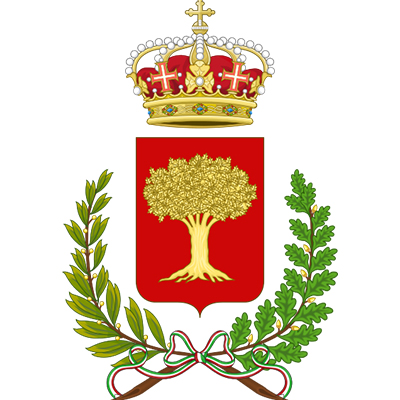
Municipality of Bisceglie
T + 39 080 395 0111
Municipal Police
T + 39 080 336 6611
Tourist Information Point
Via Ottavio Tupputi 1
T +39 080 373 9912
info@comune.bitonto.ba.it
Highlighted Municipalities


 it
it en
en fr
fr es
es de
de pt
pt